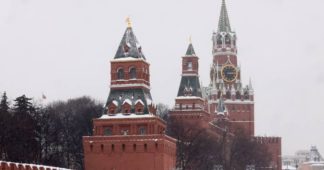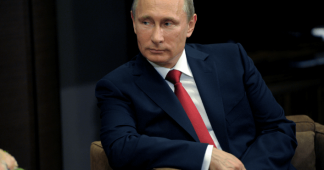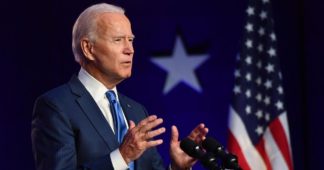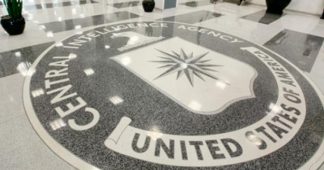Ukraine is asking for new ‘security guarantees’ from the West which will only ratchet up the spending and risk a nuclear spiral, say critics.
James Carden
Sep 21, 2022
Three months after the Russian invasion, Ukraine is no longer talking specifically about NATO, but rather a series of “binding” security guarantees now being sought from its Western partners.
Last week, former NATO Secretary General Anders Fogh Rasmussen and Ukrainian presidential aide Andriy Yermak, the co-chairs of the Working Group On International Security Guarantees for Ukraine, published the Kyiv Security Compact. The elaborate document includes a “multi-decade effort of sustained investment in Ukraine’s defence industrial base, scalable weapons transfers and intelligence support from allies” through “binding” bilateral agreements between Ukraine and a “core group of allied countries” including the U.S., UK, Canada, Poland, Italy, Germany, France, Australia, and Turkey, as well as Nordic, Baltic, Central and Eastern European countries.
So far the response in the West to the proposed compact has been muted, but it triggered a belligerent retort from Leonid Slutsky, the chair of the State Duma Committee on International Affairs of the Russian Federation. He charged that “this is not a security guarantee, it is a draft pact on the involvement of NATO countries and their allies in the conflict. The proposal is against Russia, against a nuclear state. I hope that all of Kyiv’s Western partners are well aware of what they are being asked to sign up for.”
The laundry list of security guarantees envisioned by Rasmussen and Yermak comes at a time when support for the Biden administration’s Ukraine policy of sending arms, financing, and intelligence sharing has found strong support in both houses in Congress, in the U.S. media, and among the public at large.
Yet worryingly, the relation between unanimity of opinion and sound judgment tends toward the inverse. The Rasmussen-Yermak report would require a boost in U.S. resources beyond the billions that it is already sending to the Ukraine war effort, as well as a commitment that falls just short of the kind of NATO guarantees that played into Russia’s break up with the West in the first place.
While not taking on the proposal for new security guarantees directly, a new report from Brown University’s Cost of War project, published on September 15, takes aim at the current escalation dynamics, and makes the critical case for a far more cautious approach than envisioned by either the Rasmussen-Yermak report or the U.S. bipartisan foreign policy consensus (aka ‘the Blob’).
The report, “Threat Inflation, Russian Military Weakness, and the Resulting Nuclear Paradox: Implications of the War in Ukraine for U.S. Military Spending,” counsels against an increase in U.S. and NATO defense spending as a response to Vladimir Putin’s illegal war on Ukraine.
“It is important that the U.S. not succumb to threat inflation in regards to public and official perceptions of Russia,” because “historically, threat inflation has led to disastrous and unnecessarily costly U.S. foreign policy decisions,” writes the report’s author, Lyle Goldstein, visiting professor of International and Public Affairs at the Watson Institute at Brown University.
Goldstein ably and succinctly takes the reader through the long history of threat inflation by the U.S. foreign policy establishment with regard to Russia, including the fictitious “missile gap” coined by then-Sen. John F. Kennedy during the late Eisenhower years.
The reason Goldstein, who for 20 years served on the faculty at the U.S. Naval War College, counsels restraint is due to what he calls the “nuclear paradox.” Namely, “if the U.S. and NATO increase their military spending and conventional forces in Europe, the weakness of Russian conventional military forces could prompt Moscow to rely more heavily on its nuclear forces.” After all, on the conventional weapons front, the Russians are far outspent by their rivals in the West. As he points out:
…the Russian defense budget amounts to less than 1/10 of the U.S. defense budget, just 1/5 of NATO (non-US) spending and a measly 6% of the NATO defense spending on aggregate.
Given Russia’s poor performance on the battlefield and its clear inability to militarily threaten NATO territory, Goldstein says “the Russian invasion of Ukraine, however tragic from a humanitarian point of view, does not justify the massive increase in U.S. defense spending that is currently being contemplated.”
Indeed, the report shows how Russia’s inferiority in conventional weapons has incentivized it to focus on its nuclear deterrent. And here Goldstein cites an unclassified report from the Naval War College on “nuclear use”:
“Moscow is unlikely to use nuclear weapons … unless the Putin regime judged that an impending defeat during conflict would undercut the government’s legitimacy and create an existential threat via domestic upheaval (through loss of territorial integrity or other pivotal wartime event).”
“Thus,” writes Goldstein, “the paradox of Russia’s conventional weakness is fully revealed in the above prediction.”
To get off the current escalatory ladder on which the Biden administration has set us (and which the Rasmussen-Yermak report wants to institutionalize as a decades-long project), Goldstein sensibly recommends “direct talks, reviving the arms control agenda, and pursuing military confidence building measures between NATO countries and Russia.”
Senators, members of Congress, their staffs, and policymakers at the highest levels of the Biden administration ought to treat the new Cost of War report with the seriousness it deserves.
We remind our readers that publication of articles on our site does not mean that we agree with what is written. Our policy is to publish anything which we consider of interest, so as to assist our readers in forming their opinions. Sometimes we even publish articles with which we totally disagree, since we believe it is important for our readers to be informed on as wide a spectrum of views as possible.











